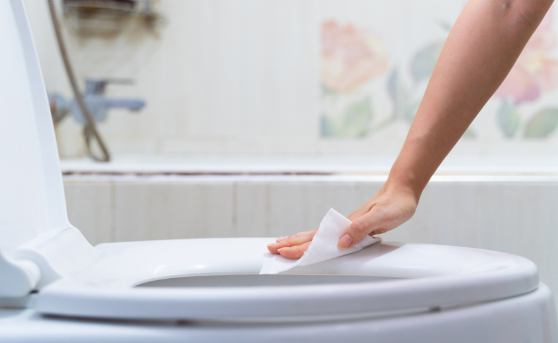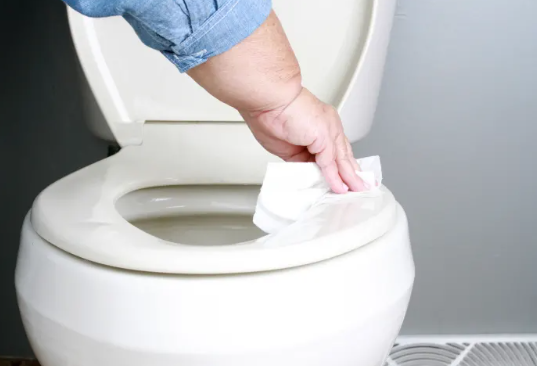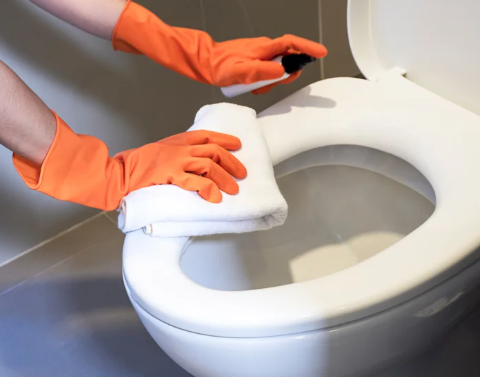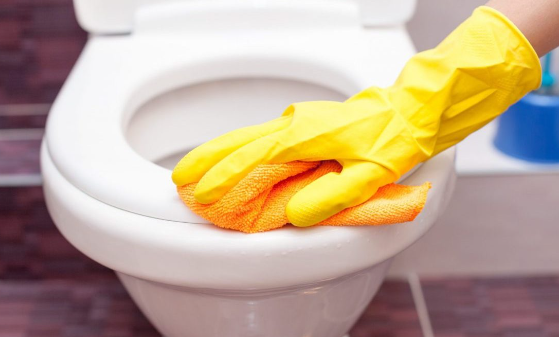Have you ever wondered what that dreaded black residue on your beloved toilet seat really is? While your bathroom is a sanctuary of quiet reflection, an unexpected blot of black can mar the tranquility of your porcelain throne.
The black residue on toilet seats can be caused by various factors, and it’s essential to identify the source of the residue to effectively clean and prevent its recurrence. Some common causes of black residue on toilet seats include:
- Mold and Mildew
- Mineral Deposits
- Fecal Residue
- Stains and Grime
To eliminate the black residue, you should clean your toilet seat regularly, use appropriate cleaning products, and employ various preventive measures that we’ll discuss below.
Causes of Black Residue on Toilet Seats
First things first, what are the causes of these ugly black residues on toilet seats?
Poor Cleaning Practices: Scrub-a-Dub-Dub or Not?
Picture this: a bustling morning, a hasty toilet visit, and a lackluster swipe of a toilet brush. Voila! The perfect breeding ground for black residue.
Inadequate cleaning allows a conglomeration of bacteria and grime to accumulate, resulting in an uninviting deposit on your toilet seat.
You see, this residue isn’t just an artistic expression of poor hygiene; it’s an unsolicited reminder that regular, thorough cleaning is a non-negotiable bathroom commandment.
Mold and Mildew Growth: The Fungus Among Us
Ah, mold and mildew – nature’s unwanted interior decorators. Bathrooms, with their warmth and humidity, provide the ideal haven for these unwelcome guests.
Left unchecked, they embark on a transformative journey, turning your once-spotless throne into a canvas for their dark artistry.
The result? The infamous black residue. So, my friends, the next time you luxuriate in a steamy shower, remember that a well-ventilated bathroom is your best line of defense against this artistic invasion.
Read more: What to Do When Your Luxe Bidet Toilet Seat Doesn’t Fit

Hard Water Stains: The Hard Truth About Minerals
If your water’s mineral content could rival a geological museum, you’re grappling with hard water. Those minerals, usually harmless to your health, become the architects of hard water stains.
Over time, these stubborn deposits evolve into black residue, a skincare nightmare for your toilet seat. But don’t despair!
Armed with the knowledge of specialized cleaning techniques, you can bid adieu to these mineral remnants and restore your throne’s lost luster.
Read more: Toilet Bowl Slowly Loses Water: How to Fix
Inner Thigh Dirt
Inner thigh dirt on toilet seats typically refers to the accumulation of dirt, sweat, and possibly other bodily residues that can be left behind on the inner part of a toilet seat due to contact with the inner thighs or other parts of the body.
This can happen when people use the toilet without fully sitting down or when they have direct skin contact with the seat. The inner thighs can come into contact with the seat, especially if someone hovers above the seat instead of sitting on it.
To maintain hygiene and cleanliness in shared or public restrooms, it’s important for both users and maintenance staff to regularly clean and disinfect toilet seats. This helps prevent the buildup of dirt, bacteria, and other potentially harmful substances.
If you encounter a toilet seat with inner thigh dirt, it’s recommended to either use a toilet seat cover, if available, or to clean the seat before using it.
Proper hygiene practices and regular cleaning can help reduce the risk of spreading germs and maintaining a clean environment for all users.
Read more: Pros and Cons of Skirted Toilets
Health and Hygiene Implications Of Black Residue On Toilet Seats
Now, let’s highlight some common implications of these unwanted guests:
Bacterial Growth: The Germy Get-Together
Moisture, warmth, and a splash of negligence – the recipe for a bacterial soirée! Bacteria thrive in these cozy bathroom conditions, and they’re not shy about leaving their mark. That mark?
Black residue, of course. So, before you postpone your bathroom cleaning in favor of other pursuits, remember that you’re essentially rolling out a red carpet for these microscopic party crashers.
Skin Irritation: No Room for Rashes
Let’s talk about skin irritation – the unpleasant side effect of an encounter with black residue. It’s not just about discomfort; for those with sensitive skin or allergies, it could be a recipe for trouble.
Your toilet seat should be a haven of comfort, not an unwitting catalyst for an itchy aftermath. So, before you park yourself without a second thought, consider the consequences – your skin will thank you.
Read more: Dealing with a Toilet Brush Head Stuck in the Toilet

How to Clean and Prevent Black Residue On Toilet Seats
Here are some tips on how to clean and prevent these ugly residue:
Cleaning Supplies and Techniques: The Magic Elixir
Ready to face the black residue head-on? Don your gloves, arm yourself with the appropriate cleaning arsenal, and let’s commence the battle!
Different culprits demand tailored solutions – from mold-banishing sprays to hard water stain removers, you’ll find an array of weapons in your cleaning arsenal.
And don’t forget: proper ventilation is your secret weapon in your fight against mold’s stealthy advances.
Regular Maintenance: A Date with Destiny
You’ve vanquished the black residue once and for all – or have you? The key to an ongoing victory lies in routine maintenance. Dedicate a few minutes each day to preserve your toilet seat’s pristine state.
By weaving this task into your daily routine, you’re taking a preemptive strike against future residue invasions. Future you will raise a thankful toast to your proactive self.
Read more: Why Did My Toilet Seat Turn Yellow After Bleaching?
Using Toilet Seat Covers: The Disposable Defender
Enter the unsung hero of bathroom etiquette: disposable toilet seat covers. These humble warriors serve as a protective shield against potential residue encounters.
Imagine them as capes for your throne – shielding you from unwanted residue while sparing you from the messier aspects of bathroom diplomacy.
Plus, with environmentally-conscious options available, you’re making a statement for both cleanliness and sustainability.

When To Seek Professional Help
Despite your valiant efforts, sometimes the black residue remains resilient. Fear not; this isn’t a reflection of your cleaning prowess. It’s a mere indication that it’s time to summon the professionals.
Equipped with specialized tools and expertise, these cleaning gurus will tackle even the most stubborn of residue cases. Consider it a spa day for your toilet seat – a gift it truly deserves. Professional cleaning services aren’t reserved for the faint-hearted.
They’re for anyone who seeks the luxury of a spotless throne without the toil. These experts delve into the root causes, ensuring that your toilet seat remains in impeccable condition, ready to withstand whatever challenges life – and bathroom visits – may throw its way.
Read more: How to Protect the Floor Around Your Toilet
Conclusion
As our journey through the world of black residue on toilet seats draws to a close, reflect on the insights gained. From uncovering the causes to exploring the potential health implications, you’ve armed yourself with the knowledge to combat this unwelcome intruder.
Remember, your toilet seat deserves to be more than just a canvas for microbial art or a breeding ground for discomfort.
By embracing proactive cleaning and maintenance strategies, and even seeking professional help if necessary, you’re liberating your bathroom throne from the clutches of black residue.
So, share your newfound wisdom, and let’s elevate the hygiene of bathrooms everywhere. After all, a clean throne is a happy throne – and every toilet seat deserves a little happiness!
Read more: Saniflo Toilet and Sink: The Perfect Duo
What are the health and hygiene implications of black residue on toilet seats?
Black residue can lead to bacterial growth, posing health risks. Bacteria thrive in moist and warm conditions, commonly found in bathrooms. Additionally, the residue can cause skin irritation, particularly for those with sensitive skin or allergies. Regular cleaning is essential to prevent these issues and maintain a comfortable and hygienic bathroom environment.
How can inner thigh dirt contribute to black residue on toilet seats, and how can it be addressed?
Inner thigh dirt refers to the accumulation of dirt, sweat, and bodily residues on the inner part of a toilet seat. It occurs through contact with the inner thighs or other body parts. Regular cleaning and disinfection, as well as the use of toilet seat covers, can help prevent the buildup of dirt, bacteria, and maintain hygiene in shared or public restrooms.
What are the common causes of black residue on toilet seats?
Black residue on toilet seats can be attributed to several factors, including poor cleaning practices, mold and mildew growth, hard water stains, and the accumulation of inner thigh dirt. Identifying the source is crucial for effective cleaning and prevention.







